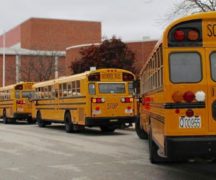In a survey released Monday, the overwhelming majority of economists said cuts to public education funding proposed by Republican Ohio House Speaker Matt Huffman would dampen the state’s future economic output at the same time that they would increase inequality in an already unequal state.
According to the Ohio Supreme Court, the state’s public schools have been chronically underfunded. Over the past several years, the Ohio General Assembly has attempted to address the problem through the Cupp-Patterson plan passed as part of the state budget. Because it was included in the state budget, it wasn’t fully funded, so full implementation will only come if lawmakers approve the third and final phase of funding in the two-year state budget due July 1.
[RELATED: Ohio governor’s proposed budget includes public ed funding, tax hikes on weed, tobacco and betting]
But fresh off championing nearly $1 billion in new money for families sending their kids to private and religious schools last year as Senate president, Huffman last month said Ohio’s public school funding was “unsustainable.”
A panel of Ohio economists said Huffman’s proposed $325 million-a-year cut to the state’s public school funding would be a huge mistake. Not only would that put poor families even further behind, it would sap the state’s economic output in the long run, the economists agreed by large margins.
Scioto Analysis surveyed 17 Ohio economists and asked if they agreed that “cutting school spending by $650 million (over two years) would significantly reduce the state’s future economic output.” Fourteen, or 82%, agreed, while two were uncertain. Just one disagreed.
In the comment section of the survey, Bill LaFayette of Regionomics said it all goes back to why we spend money on public schools in the first place.
“School spending is not an expenditure, it is an investment in our future workforce,” he wrote. “If we don’t have the revenue to support our schools, colleges, and universities adequately, perhaps we should rethink some of those tax cuts.”
Kathryn Wilson of Kent State University said the costs from cutting education would be multiple.
“There are two effects I foresee,” she wrote. “One is that there will be less productivity because there will be less human capital (fewer high school graduates, lower test scores and skills). A second effect is that there will be more reliance on government assistance programs and criminal justice costs due to the lower graduation rates and earnings potential of Ohio’s students.“
The economist who disagreed that cutting spending on public education would harm economic output, Michael Jones of the University of Cincinnati, didn’t explain his thinking.
A similarly large majority of economists agreed that “cutting school spending by $650 million would significantly increase inequality in Ohio.” Again, 14 agreed, two were uncertain and one disagreed.
Such inequality is already a big issue in the Buckeye State. A 2024 analysis said that the lowest-paid 20% of Ohioans paid twice as much of their incomes in taxes as the highest-paid 1% did. Also, more than a quarter of Ohioans are poor enough to qualify for Medicaid, meaning that for an individual woman who isn’t pregnant, she makes less than $21,600 a year.
Helping drive inequality might be such mechanisms as Ohio’s $1 billion-a-year LLC tax break. Sold on promises that it would supercharge the state economy, its boosters haven’t been able to show it’s had any effect. Most of its benefit, however, accrues to the wealthiest Ohioans.
There’s also more than $1 billion the state has forgone in liquor franchise taxes to fund JobsOhio, which according to its own metrics, has shown middling performance. And Gov. Mike DeWine continues to give tech giants massive tax cuts to build data centers that would create relatively few jobs, and that the companies may well have built without the tax breaks.
In the Scioto Analysis survey, the economists said Huffman’s school funding cuts would only exacerbate inequality.
“Public education funding has always been America’s biggest spending program for reducing inequality,” wrote Jonathan Andreas of Bluffton University. “In places without any public education funding, there is huge inequality in education which causes huge inequality in income.”
Wilson of Kent State said that less state funding for public schools meant more reliance on local property taxes. Therefore, poorer districts would have poorer schools.
“The purpose of the funding (Huffman proposes to cut) was to have less reliance on local property taxes,” she wrote. “There are large differences in per-student-spending across districts within Ohio. Reducing this funding will increase those gaps and increase inequality.”
Jones of the University of Cincinnati was the sole economist to disagree that slashing public school funding would increase inequality, but again he didn’t offer an explanation for that stance.




